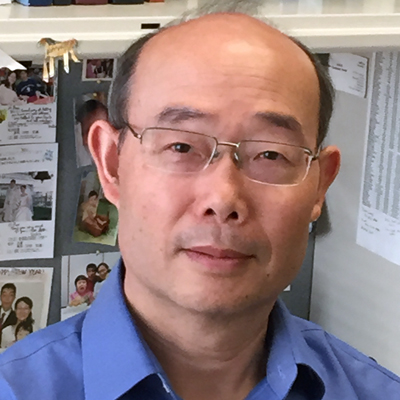Understanding viral genome evolution to seek solutions in inhibiting infections
Viral infection is a constant threat to human health and agricultural production. New variants always appear that may render antiviral therapies, like vaccines, ineffective. Some new viruses are transmitted from animals to humans to cause devastating diseases, and it is critical to understand the structure of a viral genome to develop therapies that inhibit infection. Dr. Biao Ding, Professor of Molecular Genetics at The Ohio State University, studies the 3-dimensional (3D) structure of a viral RNA genome to lay a foundation for identifying new drug targets, in a field where there has been a general lack of productive tools to investigate the RNA 3D motif structure-function relationships at the whole genome level by virologists. His group is currently pioneering the integration of different cutting-edge approaches to genome-wide 3D structural prediction and validation and to approach these from an evolutionary perspective. To identify the rules that dictate how a virus genome will change and evolve over time, Dr. Ding is developing novel methods that will probe the 3D structure of the RNA, facilitating breakthroughs in the research field of infectious diseases, including the HIV and the Ebola viruses.
The structure of a viral genome is the backbone of how it functions to establish infection and how it evolves to invade new tissues and new species. Developing structural models of viruses is therefore extremely important to predict the emergence of new virus variants, and to advance innovative preventive and curative therapeutics. Dr. Ding foreruns these models to identify the 3D motifs in the viral RNA that may change very slowly or are conserved among different viruses, in hopes of using them as potential targets for designing new drugs that will be long-lasting and more effective. As most drugs target proteins, researching viral RNA structures may offer alternative and effective new solutions for controlling infections in a timely fashion.
Current projects include:
- Understanding how new viruses emerge: An RNA genome not only encodes proteins through sequence information, but also folds into distinct local and global structural elements that perform critical regulatory functions. Because RNA-RNA or RNA-protein interactions critical for function are often mediated by local 3D structural motifs, a key to understanding viral RNA genome evolution and function is a genome-wide knowledge of these motifs. Using a very small virus-like infectious RNA called viroid that infects plants as a tractable model, Dr. Ding has made a significant progress by combining structural prediction and mutational analyses to deduce and then confirm the 3D structures of many viroid RNA motifs. The team is now applying their novel approach to characterize the 3D structures, at the genome-wide level, of medically and agriculturally important viruses. Ultimately, Dr. Ding hopes to develop methods based on this approach to predict the emergence of new virus variants, and to help develop new therapies.
- Developing technology to examine 3D structures of different RNAs: Hundreds of non-coding circular RNAs (i.e., circular RNAs that do not encode proteins) have been found in humans and other organisms, and some have been shown to be associated with human diseases. Very little study has been done about their structures. Dr. Ding hopes to apply the novel approach his team has developed to understand how these non-coding RNAs are structured and function to affect human development and cause diseases.
- Designing new RNAs with novel functions: Once the team understands the virus RNA and non-coding RNA structures and functions, they can help design new RNAs with novel functions. Thus, by providing insight into the underlying principles of RNA 3D structures, Dr. Ding accelerates breakthroughs in other researchers including those studying HIV and Ebola infections and those engineering novel RNAs.
Bio
Biao Ding grew up in a small village in a remote mountainous area in Yunnan Province, China. His family was very poor, and for more than 10 years, his father worked for the government and could only come home for Chinese New Year due to poor transportation, and his mother took care of three and then five children in the village. There was no electricity in the village, and going from place to place was only done by foot, as there were no cars, no trucks and no bicycles.
With that, Biao recalls how he would look forward to Chinese New Year every year – his father came home for a few days to add festivity, and it was the only time the family could have a little bit of rice (other times they would eat boiled plain potatoes or corn for months without much flavors) and meat. “One million dollars today would not give me the same excitement and joy that little bowl of rice — often mixed with corn meal — or a few pieces of meat gave me then,” Biao remarks.
Biao missed the first semester of his first grade in his own village because he had to babysit his little brother at home so that his mother could work in the field. He still very much enjoyed learning, so he would go listen to the teacher outside the classroom with his baby brother on his back, and come back home practicing writing Chinese characters on the walls using self-made chalks from mud. The teacher, the only one in the entire village, later talked to his mother into letting him attend the second semester. When he started third grade, he and other children had to walk to another village for schooling. He was really tired of walking for hours each day, often in the mud without shoes. Very occasionally, he could see a commercial truck on a bumpy road far away. That was very exciting to him – it was something so civilized and yet unreachable. He wished that he could ride a truck so he didn't have to walk. His mother told him that if he wanted to drive a truck when he grew up, he should study hard, as only factories had trucks at the time and for a farmer to get a factory job like driving a truck was extremely difficult and almost impossible.
After school each day, Biao worked in the the field to help support the family – doing anything a village kid could do including hand-ploughing the field, planting crops, applying pesticides, harvesting, etc. In 1972, his family moved to the little city his father was working in to be united with him after 10 years of constant effort. China held the first nationwide college entrance exam for the first time in 1977, after a 10-year gap due to the Cultural Revolution, and Biao was selected by Beijing Forestry College. His big sister, who is a very talented self-taught singer, was also interested in going to college — but had to sacrifice her career for Biao because the family could not support two college students. When Biao entered college, he was one of the two youngest; the oldest students in his class were 32. The college years were very exciting, and he spent all the time studying. He had become very interested in science during high school years, and wanted to be a scientist in a lab coat but there was not much research being done in China at that time.
During the final year in college he passed a national exam for selecting students to pursue graduate studies overseas. With a Chinese government fellowship, he attended Cornell University in 1983 to study plant science for a M.S. degree. After completing his M.S. studies he continued to pursue a Ph.D. degree in plant cell biology at Cornell and graduated in 1991. From there he went on to pursue postdoctoral research at the University of California, Davis, starting to collaborate with researchers from many institutions to investigate how viruses move between cells to propagate infection.
For Biao, the joy of doing research is beyond making new discoveries. His unique background has allowed him to appreciate every small and big opportunity. He cherishes the growing up experiences in China, and values the privileges he has had in the US to explore exciting new research and life. With the academic and supporting structure in the US, he was able to begin his career as a plant anatomist, then a cell biologist, and ventured into molecular biology, and now into RNA structure, virology, biochemistry and genomics. It is very exciting to work with all kinds of colleagues — faculty and students and postdocs — to explore new frontiers of research, making new discoveries none of us can do alone. For his virology work now, there is also a sense of responsibility to help discover how a virus evolves and works so that perhaps the knowledge he gains can be used to develop new treatments. Through collaborations, he makes new friends. He trains students and postdocs to become new generations of researchers to advance science. Biao is most gratified seeing the successes of his former students and postdocs in their careers.
Outside the lab and office, Biao enjoys climbing mountains and walking on nature trails. His fascination with mountains apparently came from his childhood life in the mountainous village. He also likes swimming, and is learning dancing. He loves foods from different cultures. He took piano lessons for two years while at Cornell, and hopes he can pick up piano again sometime in the future. Starting from those piano lessons, music has been an important part of his life.
For more information, visit https://molgen.osu.edu/people/ding.35
Publications
Awards
Fellow, American Association for the Advancement of Sciences, Elected 2012
Harlan Hatcher Memorial Award for Excellence, 2005
The Colleges of Arts and Sciences, Ohio State University
Outstanding Overseas Youth Research Award, 1/1/2005-12/31/2007
National Science Foundation of China (30428021)
The College of Arts and Sciences Faculty Council Junior Faculty Award for Scholarly Excellence, 1999
Oklahoma State University
Graduate Fellowship for Overseas Studies, 1983-1985
The Chinese Government


